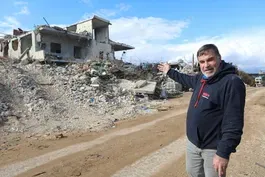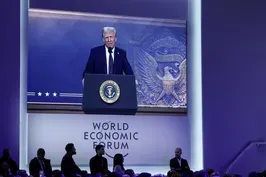
The steps an Ohio county took to reduce infant mortality
Clip: 1/23/2025 | 8m 17sVideo has Closed Captions
The steps an Ohio county took to reduce infant mortality rates
When it comes to infant mortality, the United States ranks 54th in the world. That's about three times that of Japan, Singapore or Slovenia. Within the U.S., Ohio is in the bottom 25 percent of all states. Hamilton County was even worse until it started working on saving newborns a decade ago. Paul Solman went there to find out how they’ve done it. It's part of our coverage of Race Matters.
Major corporate funding for the PBS News Hour is provided by BDO, BNSF, Consumer Cellular, American Cruise Lines, and Raymond James. Funding for the PBS NewsHour Weekend is provided by...

The steps an Ohio county took to reduce infant mortality
Clip: 1/23/2025 | 8m 17sVideo has Closed Captions
When it comes to infant mortality, the United States ranks 54th in the world. That's about three times that of Japan, Singapore or Slovenia. Within the U.S., Ohio is in the bottom 25 percent of all states. Hamilton County was even worse until it started working on saving newborns a decade ago. Paul Solman went there to find out how they’ve done it. It's part of our coverage of Race Matters.
How to Watch PBS News Hour
PBS News Hour is available to stream on pbs.org and the free PBS App, available on iPhone, Apple TV, Android TV, Android smartphones, Amazon Fire TV, Amazon Fire Tablet, Roku, Samsung Smart TV, and Vizio.
Providing Support for PBS.org
Learn Moreabout PBS online sponsorshipAMNA NAWAZ: When it comes to infant mortality, the United States ranks 54th in the world.
That's on par with countries like Romania, Hungary and the United Arab Emirates and three times the death rate of Japan, Singapore or Slovenia.
Within the U.S., Ohio is in the bottom 25 percent of all states.
And, within Ohio, Hamilton County was even worse, until it started working on saving newborn lives more than a decade ago.
Today, Hamilton County has improved and is aiming to cut its rate even lower.
Paul Solman went there to find out how they have done it for our coverage of Race Matters.
PAUL SOLMAN: Single mom India Brown says bringing son Makai (ph) into the world two years ago was a near catastrophe.
INDIA BROWN, Mother: Very early, on about 20 weeks through the rest of my pregnancy, I was actually on bed rest.
PAUL SOLMAN: Because her baby seemed about to be born four months early.
INDIA BROWN: I had several hospital stays, several emergency visits just in the middle of night, trying to keep the baby safe, keep him alive, keep him growing.
PAUL SOLMAN: That's that guy over there?
INDIA BROWN: Yes, exactly.
INDIA BROWN: He made it to 40 weeks and he actually wanted to stay longer.
It was really weird.
We were so worried he wouldn't do that.
PAUL SOLMAN: She and her son survived in a historically perilous place for newborns.
MEREDITH SMITH, Executive Director, Cradle Cincinnati: We had the second highest infant mortality rate of a county our size in the nation.
PAUL SOLMAN: That was back in 2011, says Meredith Smith, head of Cradle Cincinnati, an organization created to lead Hamilton County's effort to reduce infant mortality, death within one year of the baby's first heartbeat, first breath.
MEREDITH SMITH: The way that our society is measured is the way that we treat our babies.
So if we have babies dying at an alarming rate, we have a societal problem.
PAUL SOLMAN: In 2011, Hamilton County's rate and Ohio's was well above the national average, with Black babies 3.5 times more likely to die than white babies.
The top cause in the county and the top cause everywhere, what India Brown's baby almost suffered.
DR. PATRICIA GABBE, Ohio State University: Extreme prematurity, which means that baby is not in utero past 28 weeks, past 26 weeks, past 24 weeks.
PAUL SOLMAN: Pat Gabbe is an OB-GYN doctor at Ohio State University.
DR. PATRICIA GABBE: That extreme premature baby, it starts out life with a disadvantage, and two and three times more Black babies are born very, very early as white babies.
And that's where the disparities begin.
PAUL SOLMAN: And so the infant mortality disparity begins there too, because of the health of Black mothers says Dr. Gabbe.
DR. PATRICIA GABBE: They age more prematurely that our white moms, so they have more hypertension, weathering, we call it, from the stress of their living environments.
PAUL SOLMAN: Five years into its project, Cradle Cincinnati decided to focus more narrowly, on the Black infant mortality rate.
MEREDITH SMITH: We must change this rate in order to see success.
As we focus on Black women and their reality, we close the gap.
PAUL SOLMAN: That focus included a massive county outreach to all pregnant moms, getting them to doctor's offices, at-home visits from health care workers, even billboards and social media, but not just to prevent premature births.
MEREDITH SMITH: We have identified three issues that we knew were impacting infant mortality, the three S'es, smoking, spacing and sleep.
PAUL SOLMAN: Smoking, obvious, spacing, having babies more than a year apart to restore the mother's nutritional and internal health, sleeping to prevent accidental death.
But what were the case-by-case particulars?
The county investigated.
GREG KESTERMAN, Hamilton County, Ohio, Health Commissioner: We have interviewers that go out and talk to the moms and dads and the family of that child and learn about the situation that occurred that ultimately resulted in them passing away.
PAUL SOLMAN: Greg Kesterman's County Health Commission tracks every infant death.
He says one area has become increasingly bedeviling, sleeping, now the number two culprit in the county.
We have all heard of SIDS, Sudden Infant Death Syndrome, infant death from unexplained causes, but co-sleeping with a baby accounted for most sleep-related deaths in Hamilton.
Wait a minute.
Where I am, that's often considered a very positive thing.
It's called family bed.
Yes, says Kesterman, but: GREG KESTERMAN: We have seen that contribute to infant mortality.
And, unfortunately, every single time, it's a sad, horrible story.
The parent was not intending for it to happen.
I have read instances in our review panels where a mom was holding the baby, sitting on the couch while trying to fall asleep, and the baby slipped through the arms in between the arm of the couch and ultimately passed away.
We know lots of parents work two, three jobs just to make ends meet.
And when that happens, you're super tired at night.
And the last thing you want is your child crying when you're trying to sleep.
And so an easy way often to calm your child down is by holding them or putting them in your bed with you.
You're so much bigger than the infant, and the possibility of suffocating the infant or crushing the child while you're sleeping is very high.
INDIA BROWN: This is your resource map.
PAUL SOLMAN: So how to prevent this?
Cradle Cincinnati's Queens Village program tried a new approach.
MEREDITH SMITH: What we are doing is centering Black women in particular's voice and asking them what they need.
The uniqueness of this model is that, instead of it being how we see fit for you to receive care, we think about how you want to receive care.
And that changes the way we understand caring for people in the U.S., period.
INDIA BROWN: Thinking about yourself is a radical concept as a Black woman.
PAUL SOLMAN: But that's what Queens Village provides to India Brown and other moms.
INDIA BROWN: It's very easy to put yourself on a back burner when you have been taught all your life to be a good daughter, to be a good mother, to be a good wife.
And no one talks about what it means to be a good person to yourself, to be a good human being.
I think that's a really big thing in the identity of a Black woman as a whole.
PAUL SOLMAN: Brown now leads a Queens Village wellness class that shifts the focus.
INDIA BROWN: What are the supports that, if you had them, would make your life easier?
ARIES DEES, Mother: When I'm well, our kids are well.
And I didn't really know that part to being part of the wellness.
I always thought I had to take care of them first, then me.
PAUL SOLMAN: Mothers like Aries Dees with three children, including a 9-month-old daughter.
ARIES DEES: It's teaching me that I have to make sure I'm OK to make sure they're OK. PAUL SOLMAN: Do you think she was safer as a result?
ARIES DEES: I feel so, for sure.
PAUL SOLMAN: How so?
ARIES DEES: Because my mental health is better.
If my mental health wasn't, you know, I mean, I feel like I wouldn't be -- we tend to zone out, not be as much nurturing and caring.
So, because I'm getting that here, I'm able to be more nurturing and caring for her.
PAUL SOLMAN: And so the women here find strength in community, which, in India Brown's case, not only saved her son from an extreme premature birth, but enabled her to sustain him thereafter.
INDIA BROWN: My son actually was diagnosed with failure to thrive at about 4.5 months.
He was not keeping down any food.
And so we couldn't really get nutrition in him and he was losing a lot of weight.
INDIA BROWN: So I was very scared.
And so other moms who had similar experiences could talk to me.
Other medical professionals were in the group.
There's just a lot more support to help you navigate that system and navigate that scary reality of what it looks like to deal with something so scary as, like, will he make it to his first year?
PAUL SOLMAN: As for data, since 2011, Hamilton County's overall infant mortality rate has plummeted from 10.2 deaths per thousand births down to 5.5, the national average.
And the Black rate has fallen by nearly 50 percent, narrowing the racial gap.
As for what I call anecdata, here's Makai Brown Kaiser (ph), walking support for both Cradle Cincinnati and Queens Village, now in 11 locations and expanding.
For the "PBS News Hour," Paul Solman in Cincinnati.
How global business leaders are responding to tariff threats
Video has Closed Captions
How global business leaders are responding to Trump's tariff threats (3m 16s)
Judge blocks Trump's order ending birthright citizenship
Video has Closed Captions
Federal judge puts blocks on Trump's order to end birthright citizenship (6m 30s)
Judges who oversaw cases frustrated by Jan. 6 pardons
Video has Closed Captions
After Jan. 6 pardons, judges who oversaw cases express frustrations (6m 52s)
A look at destruction in Lebanon from Israeli airstrikes
Video has Closed Captions
A look at destruction in Lebanon from Israeli airstrikes and occupation of border region (6m 42s)
Meet the team behind Watch Duty app giving wildfire updates
Video has Closed Captions
Meet the small team behind the Watch Duty app giving life-saving wildfire updates (5m 35s)
News Wrap: California crews battling new fires in LA area
Video has Closed Captions
News Wrap: California crews battling new fires in Los Angeles area (5m 26s)
Trump lays out demands in reintroduction to world stage
Video has Closed Captions
Trump lays out demands in virtual reintroduction to world stage (4m 50s)
Trump willing to use economic pressure on Russia to end war
Video has Closed Captions
Trump says he's willing to use economic pressure on Russia to end Ukraine war (4m 3s)
Providing Support for PBS.org
Learn Moreabout PBS online sponsorshipMajor corporate funding for the PBS News Hour is provided by BDO, BNSF, Consumer Cellular, American Cruise Lines, and Raymond James. Funding for the PBS NewsHour Weekend is provided by...




















